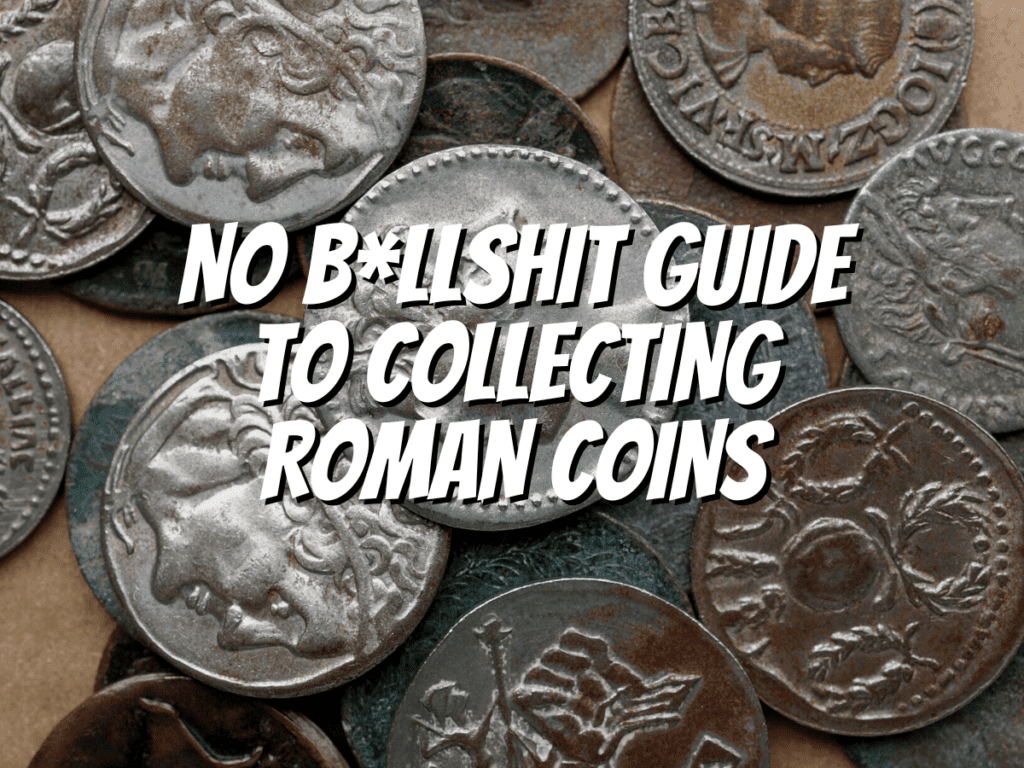As a child, I spent hours alone in my room poring over the collection of coins my grandfather had left for me. They were all ancient Roman coins—all bronze, silver, or gold—and they were fascinating.
But now that I’m older and wiser (well, at least older), I’ve learned that there’s much more than meets the eye when collecting Roman coins. So if you’re interested in starting your collection or want tips on buying and selling ancient coins with confidence, read on!
Guide to Collecting Roman Coins:
What Are Roman Coins?

Roman coins are a form of currency used in the Roman Empire. They were made from metal, usually copper or silver, and minted by the government. They were produced in a variety of shapes and sizes.
Where To Start With Roman Coin Collecting

- The first thing to do is to find out what you want. The next step is determining how much you can afford and what investment strategy makes sense.
- If you’re new at collecting Roman coins and want an easy way to get started, consider purchasing a few common coins from each period and a few rare ones in good condition. This will give you some variety without being too costly or involving too much research.
- Several things should be avoided when collecting Roman coins. You should avoid buying fake or altered pieces; these are illegal and can cost collectors dearly if they do not know what they have bought (or sold). It’s also important not to buy any coin based solely on its potential worth: some people have been known for spending their entire lives trying unsuccessfully to sell rare coins that never reach their actual value!
How To Grade Roman Coins
You will first have to learn how to grade your coins. All coins have a grade ranging from VF- (very fine) to UNC (uncirculated). The higher the grade, the better quality it is.
For example, an F+ coin would be considered very fine, and an EF coin would be extremely fine. Although there are some exceptions, most coins will follow this pattern:
- VG = Very Good
- G = Good
- F = Fine
- VF = Very Fine.
You should also remember that there is no standard grading system for ancient roman coins as they were not used like modern-day currency (i.e., they weren’t circulated).
So if you’re looking at buying or selling Roman coins online, make sure that whoever you deal with uses the same grading criteria as yourself!
Dating and Identifying Roman Coins

- You can determine the year a Roman coin was minted by examining its reverse side or obverse. Coins produced in the 1st century AD feature an image of an emperor wearing a laurel wreath and carrying a wand on their obverse. Coins produced later will show either a single emperor or multiple emperors, usually dressed in togas and holding either orbs (orbs were round globes) or scepters. The reverse side of these coins features various types of designs depending on where they were minted: some depict gods like Jupiter; others depict personifications named Victory; some show animals such as horses or lions; some portray plants such as oak trees, and still others feature symbols such as beehives (symbols associated with industriousness).
- A coin’s metal content can also help you identify its age, but not necessarily its origin. For example, many coins made from gold might have been struck during the reigns of rulers who were not from Rome itself—and thus not considered authentic “Roman” coins—yet these pieces may still be relied upon for dating purposes because they share similarities with other Roman currency at large (i.e., those minted within what historians consider “the Roman Empire”).
The Best Books and Resources for Roman Coins
- A Handbook of Roman Coins by David L. Vagi
- Coinage and History of the Roman Empire, c. 82 B.C.–A.D. 480 by David L. Vagi
- Roman Silver Coins by David R. Sear
- Roman Silver Coin Hoards by David R. Sear
The Best Websites for Buying and Selling Ancient Coins
There are several good sites from which to buy Roman coins. Here are some of our favorites:
- eBay – It is not always easy to find great pieces on eBay, but if you know what you’re looking for, there is no better place to find them than this popular auction site.
- Numis – Numis is an online marketplace where you can buy and sell ancient coins with the help of professional dealers. If you don’t have much experience in this field, it’s worth checking out their services!
- My Roman Coins – This site is run by collectors specializing in high-quality ancient coins from ancient Rome and Greece (and other regions). They offer both original pieces and replicas—it depends on what kind of product would work best for your needs!
Before you go…
We hope this guide has helped to demystify Roman coin collecting and given you some ideas of where to start. With so much information out there, it can be challenging to know where to begin—but if you keep these pointers in mind, we’re sure you’ll have a great time getting started!
Check out my next article: “A Guide to Canadian Coin Collecting.”
Related Articles:

